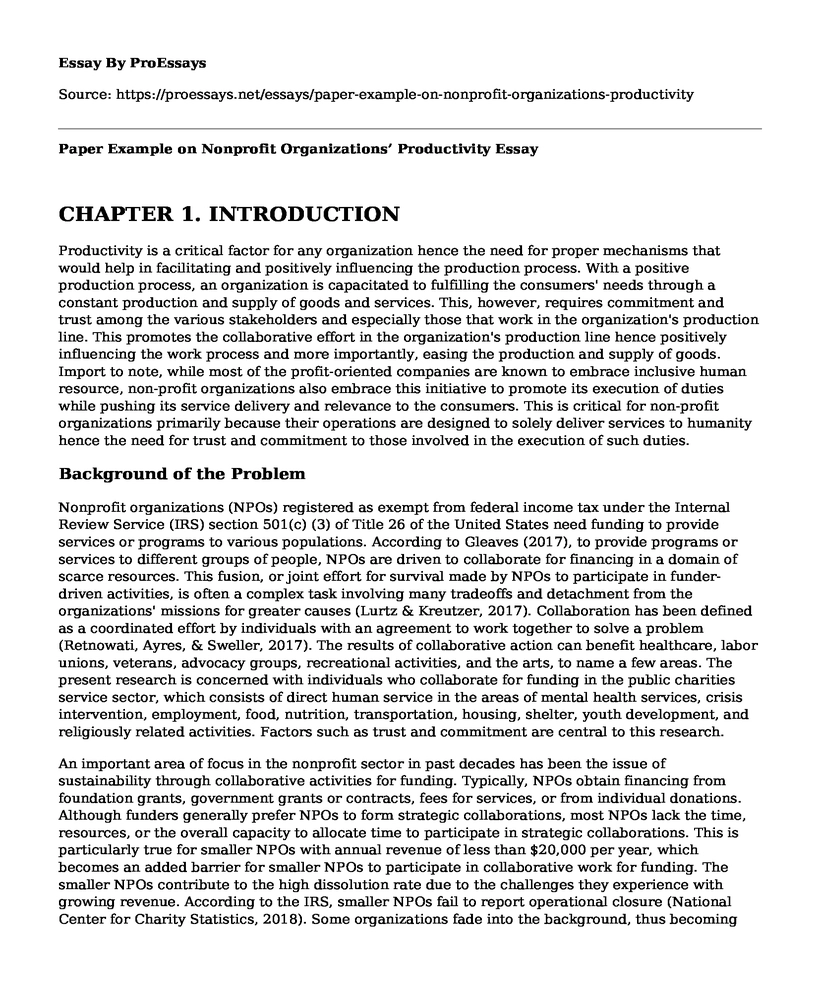CHAPTER 1. INTRODUCTION
Productivity is a critical factor for any organization hence the need for proper mechanisms that would help in facilitating and positively influencing the production process. With a positive production process, an organization is capacitated to fulfilling the consumers' needs through a constant production and supply of goods and services. This, however, requires commitment and trust among the various stakeholders and especially those that work in the organization's production line. This promotes the collaborative effort in the organization's production line hence positively influencing the work process and more importantly, easing the production and supply of goods. Import to note, while most of the profit-oriented companies are known to embrace inclusive human resource, non-profit organizations also embrace this initiative to promote its execution of duties while pushing its service delivery and relevance to the consumers. This is critical for non-profit organizations primarily because their operations are designed to solely deliver services to humanity hence the need for trust and commitment to those involved in the execution of such duties.
Background of the Problem
Nonprofit organizations (NPOs) registered as exempt from federal income tax under the Internal Review Service (IRS) section 501(c) (3) of Title 26 of the United States need funding to provide services or programs to various populations. According to Gleaves (2017), to provide programs or services to different groups of people, NPOs are driven to collaborate for financing in a domain of scarce resources. This fusion, or joint effort for survival made by NPOs to participate in funder-driven activities, is often a complex task involving many tradeoffs and detachment from the organizations' missions for greater causes (Lurtz & Kreutzer, 2017). Collaboration has been defined as a coordinated effort by individuals with an agreement to work together to solve a problem (Retnowati, Ayres, & Sweller, 2017). The results of collaborative action can benefit healthcare, labor unions, veterans, advocacy groups, recreational activities, and the arts, to name a few areas. The present research is concerned with individuals who collaborate for funding in the public charities service sector, which consists of direct human service in the areas of mental health services, crisis intervention, employment, food, nutrition, transportation, housing, shelter, youth development, and religiously related activities. Factors such as trust and commitment are central to this research.
An important area of focus in the nonprofit sector in past decades has been the issue of sustainability through collaborative activities for funding. Typically, NPOs obtain financing from foundation grants, government grants or contracts, fees for services, or from individual donations. Although funders generally prefer NPOs to form strategic collaborations, most NPOs lack the time, resources, or the overall capacity to allocate time to participate in strategic collaborations. This is particularly true for smaller NPOs with annual revenue of less than $20,000 per year, which becomes an added barrier for smaller NPOs to participate in collaborative work for funding. The smaller NPOs contribute to the high dissolution rate due to the challenges they experience with growing revenue. According to the IRS, smaller NPOs fail to report operational closure (National Center for Charity Statistics, 2018). Some organizations fade into the background, thus becoming inactive, but resurface once they can obtain adequate funding. Questions about the need for services for vulnerable seniors, the youth, and individuals living in poverty have become predominant for researchers due to economic instability (Lurtz & Kreutzer, 2017).
Recent studies have revealed that the nonprofit sector received an influx of attention from scholars and practitioners due to economic uncertainty and the need to do more with less (Gleaves, 2017). Currently, our knowledge of what influences NPOs' collaborative work concerning trust and commitment remains very limited, as much of the research focuses on the for-profit sector (Verschuere & De Corte, 2014). The few studies that do explore trust and commitment in the United States' nonprofit sector only examine trust and commitment. This study investigates the relationships among individuals who have participated in collaborative work within the last ten years with NPOs in the area of public charities focused on human services in Riverside County and San Berna...
Cite this page
Paper Example on Nonprofit Organizations' Productivity. (2023, Jan 18). Retrieved from https://proessays.net/essays/paper-example-on-nonprofit-organizations-productivity
If you are the original author of this essay and no longer wish to have it published on the ProEssays website, please click below to request its removal:
- Change for Life and the Obesity Crisis - Social Marketing Paper
- Place, Product, Price, and Promotion Essay
- Research Paper on Banking Sector and Development of Corporate Governance in Mauritius
- Essay Sample on Project Cost Overruns
- Essay Example on UTI in SCI: Risks and Prevention
- Essay Example on Leadership Through Collaboration: The Foundation for Quality Service
- Essay Example on Principles of Persuasion in Advertising: Consistency, Authority, and Liking







